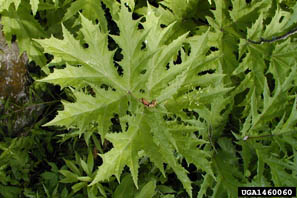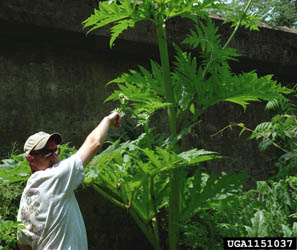Invasive Species Spotlight: Giant Hogweed (Heracleum mantegazzianum) | |
|---|---|
| July 1, 2008 | |
|
Giant hogweed (http://www.invasivespeciesinfo.gov/plants/hogweed.shtml) is a exotic weed recently introduced into the Illinois landscape. It can degrade natural landscapes and possesses health risks to people. This plant is native to the Caucasus Mountains along the border between Europe and Asia. It was exported and used in the 19th century as an ornamental plant in Europe because of its unusual growth and features. Now, it is thoroughly established in England, Scotland, France, Belgium, Germany, and Scandinavia. In North America, it has been found in Ontario, British Columbia, Maine, Maryland New York, Michigan, Washington, Oregon, and recently in northeastern Illinois in Lake and Cook counties. This species is now on the Federal List of Noxious Weeds and is illegal to propagate, sell, or transport in the United States.  Giant hogweed leaf. Photo courtesy of www.invasive.org <http://www.invasive.org/> Giant hogweed leaf. Photo courtesy of www.invasive.org <http://www.invasive.org/> Giant hogweed, also know as giant cow-parsley, belongs in the carrot, or parsley, family (Apiaceae). It has several look-alikes (http://www.hort.uconn.edu/cipwg/hogweedLookalikes/HogweedLookAlike_WEB/index.htm), including cow parsnip (Heracleum lanatum), angelica (Angelica atropurpurea), and poison hemlock (Conium maculatum)—all common plants found in Illinois. Although many of these plants may look like giant hogweed at first glance, none of them gets to be as large or has its exaggerated characteristics.  Giant hogweed plant. Photo courtesy of www.invasive.org <http://www.invasive.org/> Giant hogweed plant. Photo courtesy of www.invasive.org <http://www.invasive.org/> This biennial or short-lived perennial can grow up to 10 to 15 ft tall. It has enormous compound leaves, up to 5 ft wide on the bottom sets, with three deeply incised leaflets. Thick stems are from 2 to 4 in thick, hollow, and covered in purple blotches and course white hairs. The easiest stage of identification of giant hogweed is its flowering stage. Numerous small white flowers are borne in June or July in large, flat-topped umbels up to 2-1/2 ft across. After the flowers produce their seeds by late summer, the plant dies back to the thick taproot. Its stem may persist throughout the winter. It can typically be found growing in rich, moist soils of flood plains, streambanks, and roadsides. Colonies can be established quickly that outcompete and displace native plants and cause increased erosion along streambanks. In addition to being a noxious weed, giant hogweed can be harmful to humans. Within the plant is a sap containing furocoumarins that, when in contact with skin and exposed to ultraviolet rays, can lead to severe burning and blistering. It is very important to wear gloves when handling this plant and also to avoid smoke if this plant is being burned nearby. For more information, stop by the Illinois CAPS blog (www.illinoiscapsprogram.blogspot.com) for all the latest news on invasive pests in Illinois. (Mike Garrett and Kelly Estes) | |
| Author: | Michelle Wiesbrook |
